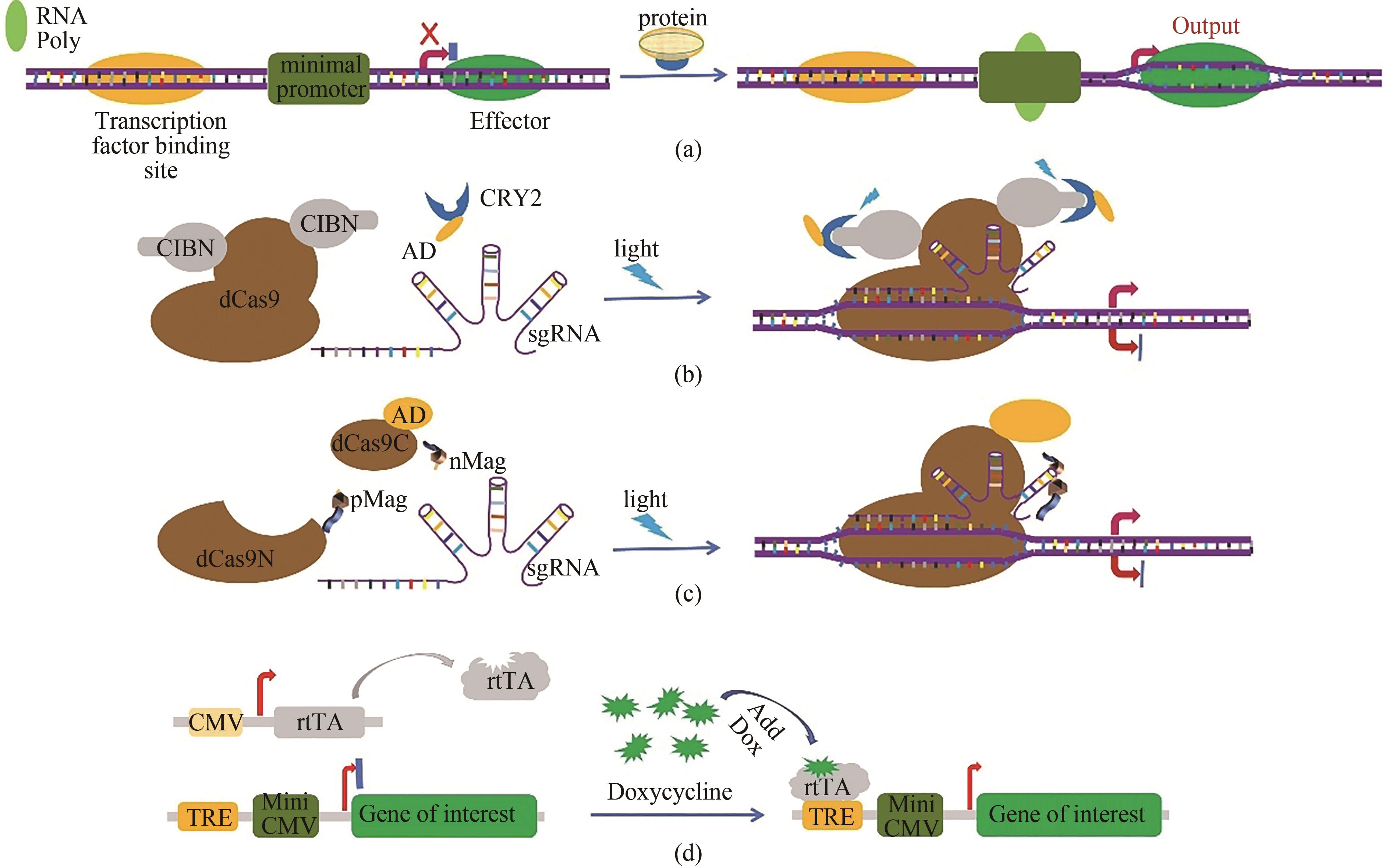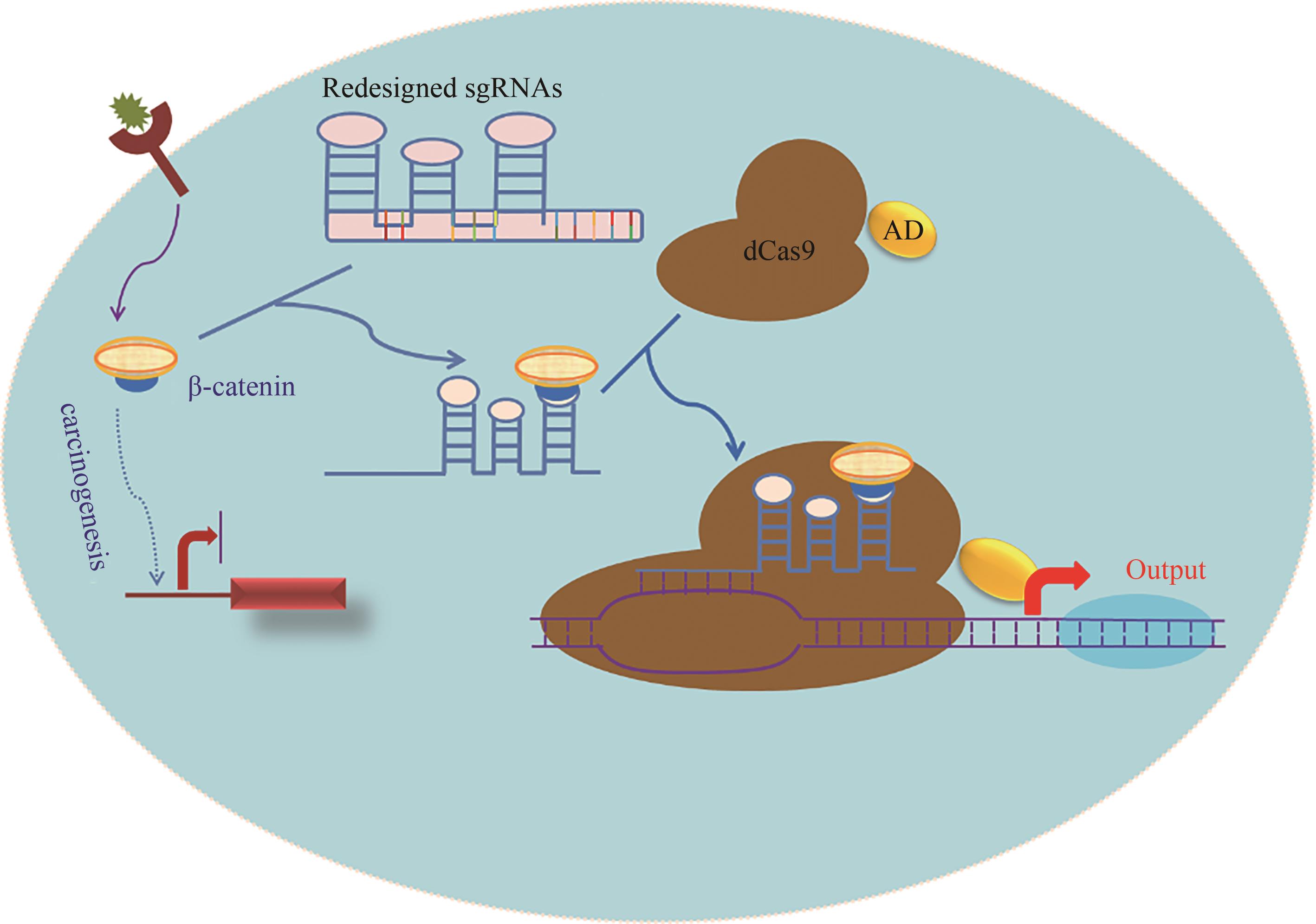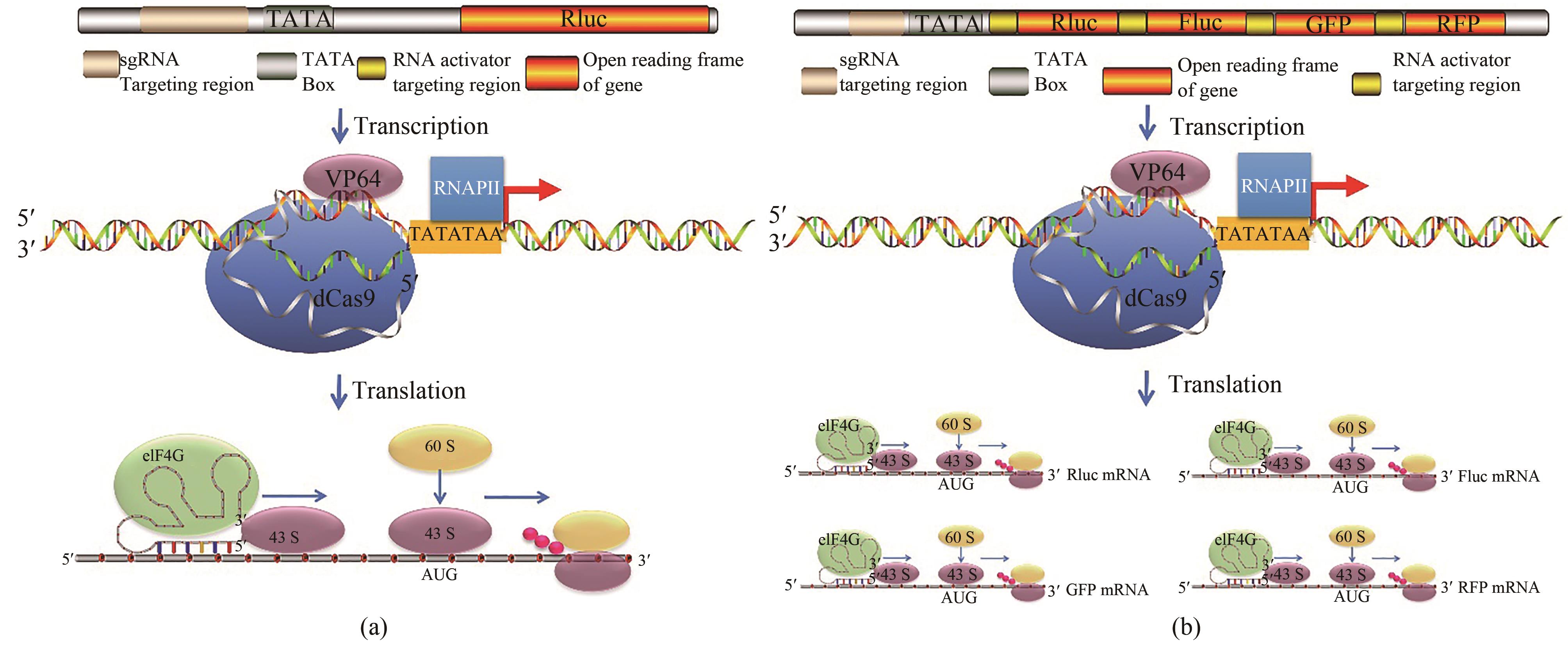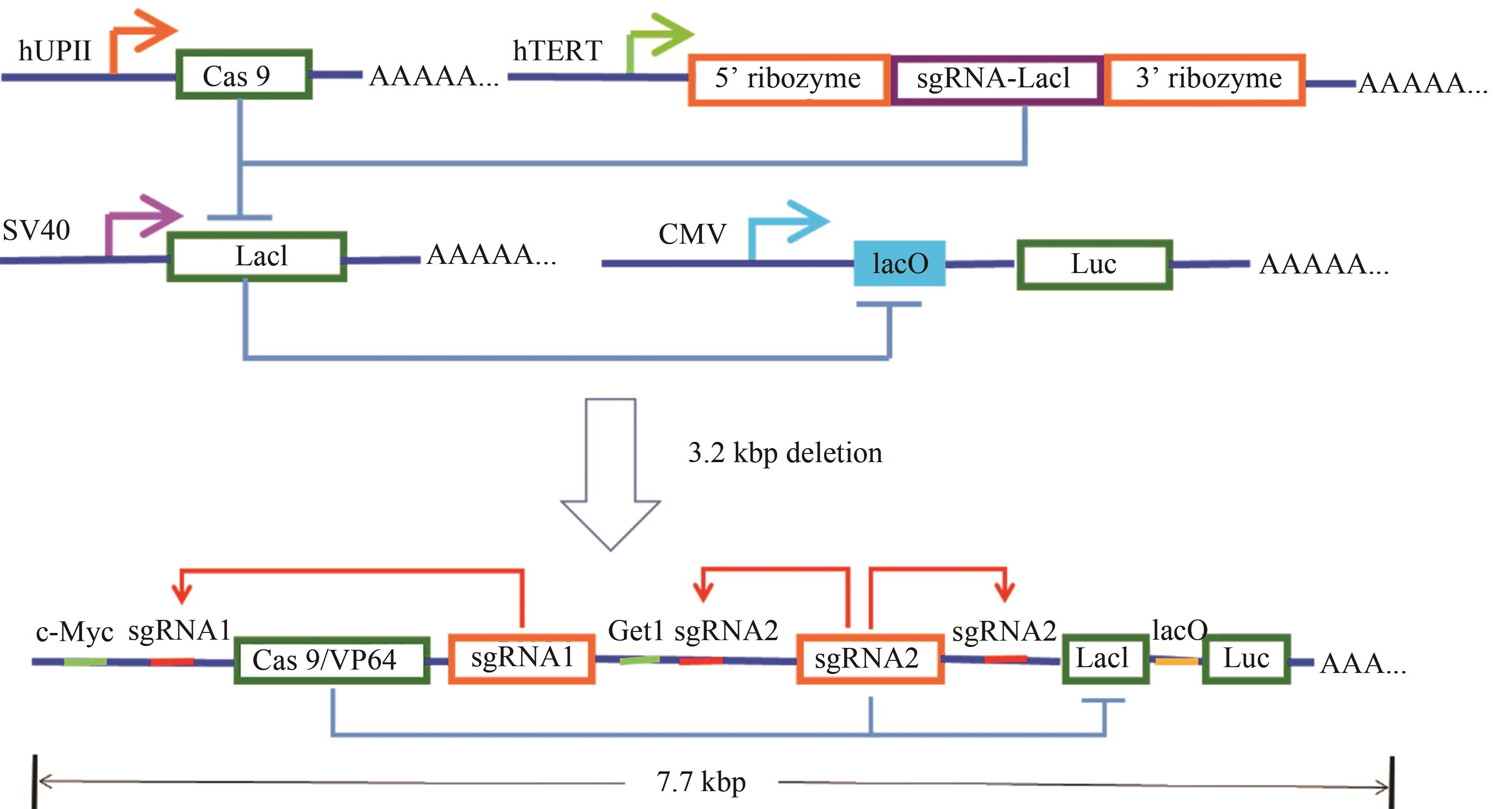合成生物学 ›› 2022, Vol. 3 ›› Issue (1): 53-65.DOI: 10.12211/2096-8280.2021-046
基于CRISPR/Cas工具的肿瘤基因线路构建及应用
宋斐1,2, 刘宇辰1,2, 蔡志明1,2, 黄卫人1,2
- 1.深圳大学第一附属医院,深圳市第二人民医院,泌尿外科,广东 深圳 518035
2.广东省泌尿生殖肿瘤系统生物学与合成生物学重点实验室,广东 深圳 518035
-
收稿日期:2021-04-15修回日期:2021-11-24出版日期:2022-02-28发布日期:2022-03-14 -
通讯作者:黄卫人 -
作者简介:宋斐 (1979—),女,副研究员,硕士生导师。E-mail:lst121@outlook.com黄卫人 (1980—),男,研究员,博士生导师。主要研究方向:(1)肿瘤基因组学,应用多组学手段鉴定肿瘤及微环境诊疗标志物,开发相关临床应用;(2)肿瘤类器官,利用体外培养系统还原肿瘤体内生长,药物筛选及耐药机制研究;(3)医学合成生物学,创新肿瘤治疗新方法。E-mail:pony8980@163.com -
基金资助:国家重点研发项目(2019YFA0906000);广东省自然科学基金(2021A1515012488)
Construction of tumor gene circuits using CRISPR/Cas tool and their applications
SONG Fei1,2, LIU Yuchen1,2, CAI Zhiming1,2, HUANG Weiren1,2
- 1.Department of Urology,The first Affiliated Hospital of Shenzhen University,Shenzhen Second People′s Hospital,Shenzhen Institute of Translational Medicine,Shenzhen 518035,Guangdong,China
2.Guangdong Provincial Key Laboratory of Systems Biology and Synthetic Biology for Urogenital Tumors,Shenzhen 518035,Guangdong,China
-
Received:2021-04-15Revised:2021-11-24Online:2022-02-28Published:2022-03-14 -
Contact:HUANG Weiren
摘要:
以恶性肿瘤为代表的难治性疾病仍是困扰我国乃至全球的一个重大公共卫生问题。近年来,合成生物学的蓬勃发展,极大推动了疾病创新治疗策略,并显示出巨大潜力。人工构建的基因线路可特异性地识别、区分疾病细胞和正常细胞,并控制疾病细胞命运,为精准治疗提供了新途径。然而构建基因线路用于疾病治疗的挑战之一是缺乏有效、可编程、安全和序列特异性的基因编辑工具。CRISPR/Cas自从首次被用于哺乳动物基因编辑以来,已被广泛应用于研究、工业和医学领域。除Cas9诱导的indel突变外,CRISPR/Cas能够进行DNA/RNA的碱基编辑,为基因线路设计提供了高效的工具,极大提高了每个线路元件效率。因此,基于CRISPR技术的智能化基因线路的应用,可有效保证癌症等疾病治疗的安全性、高效性和特异性。本文介绍了CRISPR/Cas技术应用于医学合成生物学基因线路设计的研究进展和潜在挑战。评估了使用CRISPR系统元件的合成基因线路在肿瘤治疗中的效果,尤其利用人工开关诱导的Cas9干预肿瘤细胞治疗的安全性和有效性;介绍了CRISPR/Cas9介导的信号传感器设计,其可同时识别多个蛋白质信号,实现了多基因同步调控,以及新一代体系小、特异性强、基因调控效率高的CRISPR/Cas12a系统及其遗传改造。基于无启动子表达CRISPReader元件的精简基因线路设计,其高效启动的特点极大提升了智能化基因线路在未来精准癌症治疗中的应用潜力。
中图分类号:
引用本文
宋斐, 刘宇辰, 蔡志明, 黄卫人. 基于CRISPR/Cas工具的肿瘤基因线路构建及应用[J]. 合成生物学, 2022, 3(1): 53-65.
SONG Fei, LIU Yuchen, CAI Zhiming, HUANG Weiren. Construction of tumor gene circuits using CRISPR/Cas tool and their applications[J]. Synthetic Biology Journal, 2022, 3(1): 53-65.

图1 基于CRISPR/Cas技术的人工基因线路[29](a)在CRISPR/Cas9基因序列上游插入编码转录因子结合位点的人工序列,通过感知细胞内信号蛋白来控制基因表达。在恶性肿瘤细胞中,一些特定的转录因子被异常激活,如β-catenin和NF-κB。当癌细胞中的异常信号蛋白与转录因子结合位点结合并且RNA聚合酶(RNA poly)被募集到TATA-box时,下游CRISPR/Cas9基因的表达就会开启。图中Effector指CRISPR系统的Cas9蛋白。(b)癌细胞中基于CRISPR/Cas9技术的光诱导基因表达装置。蓝光刺激诱导拟南芥隐花色素2(CRY2)与其结合蛋白(隐色素相互作用的基本螺旋-环-螺旋蛋白1,CIBN)之间形成异二聚化。因此,与CRY2蛋白融合的转录激活域(AD)被携带到指定区域,促进下游基因的表达。(c)光诱导CRISPR/dCas9的流程。dCas9被分成两个缺乏核酸酶活性的片段,dCas9片段与光诱导二聚化结构域(pMag和nMag)融合。蓝光刺激诱导pMag和nMag之间的异源二聚化,使分裂的dCas9片段能够重新结合,从而重建RNA引导的转录激活活性。(d)小分子人工开关系统。多西环素与逆四环素转录激活因子(rtTA)的结合导致rtTA构象的变化,活化后的rtTA与Tet反应元件(TRE)进一步结合从而启动靶基因的表达(如Cas9)
Fig. 1 Schematic representation for the artificial gene circuits developed based on CRISPR/Cas technology(a) artificial sequences of transcription factor binding site are inserted into the upstream of the Cas9 coding sequences to control gene expression by sensing intracellular signal proteins. In malignant tumor cells, some specific transcription factors such as β-catenin and NF-κB are abnormally activated. The expression of the downstream CRISPR/Cas genes is turned on when abnormal signal proteins in malignant cells bind to the transcription factor binding site and RNA polymerase (RNA poly) is recruited to the TATA box. Effector represents the Cas9 protein. (b) the light-inducible gene expression regulation system in cancer cells developed based on CRISPR/Cas9 technology. Blue light stimulation induces heterodimerization between A. thaliana cryptochrome 2 (CRY2) and its binding partner CIBN (cryptochrome-interacting basic helix-loop-helix protein 1). Therefore, the transcriptional activation domain (AD) fused with the CRY2 protein is targeted to the specific region and promotes the expression of downstream genes. (c) schematic diagram for the light inducible CRISPR/dCas9 system. The dCas9 is split into two fragments lacking nuclease activity, and the dCas9 fragments are fused with light-inducible dimerization domains (pMag and nMag). Blue light stimulation induces heterodimerization between pMag and nMag, which enables split dCas9 fragments to reassociate, thereby reconstituting RNA-guided transcriptional activation activity. (d) schematic diagram for a small molecular artificial switch system. The binding of doxycycline results in the conformational change of reverse tetracycline transcriptional activator rtTA, and then the activated rtTA could bind to the Tet-responsive element (TRE) to drive the expression of the target genes, such as Cas9 gene.

图2 基于 CRISPR/Cas 技术的信号传感器[β-catenin激活Wnt通路,促进肿瘤细胞增殖。人工设计的sgRNA优先结合内源性β-连环蛋白,进而被激活。接着,人工设计的sgRNA与dCas9蛋白结合,并与靶序列结合、激活输出基因,如内源性抑癌基因(如p53)或凋亡基因(如p21和caspase 3),使肿瘤细胞由癌发生信号通路重新定向为抗癌信号通路]
Fig. 2 Schematic diagram for the signal conductor that links one signal with another developed based on CRISPR/Cas technology[The β-catenin activates the Wnt pathway, and promotes the proliferation of tumor cells. The redesigned sgRNA preferentially binds to the endogenous β-catenin, and then couples with dCas9-AD protein to activate the output genes, such as the endogenous tumor suppressor genes (eg, p53) or apoptosis genes (eg, p21 and caspase 3), enabling the tumor cells to redirect oncogenic signaling to an anti-oncogenic pathway.]

图3 CRISPReader 通过耦合转录和翻译机制来驱动无启动子基因表达[52](a) CRISPReader通过组合的转录和翻译的平台构成。当dCas9-VP64融合蛋白包括1个催化失活的Cas9和1个VP64转录激活结构域,VP64结构域可招募RNA聚合酶Ⅱ,sgRNA与靶基因TATA盒上游位点同源,sgRNA与靶序列结合进一步引导dCas9-VP64结合与TATA盒上游,强力激活靶报告基因RLuc的转录。RNA激活导致转录起始因子复合物的形成,其包括eIF4G以及招募来的核糖体,这时翻译启动。(b) CRISPReader驱动基因簇表达的机制。在dCas9-VP64激活转录后,RNA激活剂与每个目标mRNA结合并独立启动mRNA翻译。RNAPII—RNA polymerase Ⅱ(RNA聚合酶Ⅱ)
Fig. 3 CRISPReader drives gene expression by coupling the transcriptional and translational mechanisms[52](a) CRISPReader is constructed by combining transcriptional and translational platforms. The dCas9-VP64 protein robustly activated transcription of reporter is constructed when combined with sgRNA targeting sequences near the TATA box. Then, the RNA activator leads to the formation of initiation factor complexes involving eIF4G and recruits ribosomes to initiate translation. (b) mechanisms of the CRISPReader designed to drive the gene cluster expression. After dCas9-VP64-mediated transcription, the RNA activators bind to each targeted mRNA and independently initiates mRNA translation.

图4 与门微型基因线路的设计与构建[54](UPII启动子驱动Cas9 mRNA的转录,而TERT启动子用于促进靶向LacI的sgRNA的转录。输出海肾荧光素酶基因受LacI控制的CMV启动子调控。荧光素酶仅在UPII启动子和TERT启动子都被激活时表达。在小基因线路的设计中,UPII和TERT启动子被它们各自的转录因子结合元件取代。c-Myc和Get1仅在膀胱癌细胞中同时具有相对较高的表达水平。sgRNA1和sgRNA2初始表达后,它们可以进一步结合自身转录起始位点的上游,通过正反馈机制放大c-Myc和Get1的转录信号,分别放大下游基因的转录。此外,LacI基因被sgRNA2敲除,荧光素酶报告基因被转录激活。在正常膀胱上皮细胞中,荧光素酶不能被有效转录,并被在背景水平表达的痕量LacI进一步沉默)
Fig. 4 Design and construction of the AND gate minigene circuits[54](The UPII promoter drives the transcription of Cas9 mRNA, while the TERT promoter is used to promote the transcription of sgRNA targeting LacI. The output Renilla luciferase gene is regulated by a LacI-controlled CMV promoter. The luciferase is expressed only when both UPII promoter and TERT promoter are activated. In the design of the minigene circuit, the UPII and TERT promoters are replaced by their respective transcription factor binding elements. Both c-Myc and Get1, only in bladder cancer cells, have a relative high expression level at the same time. After initial expression of sgRNA1 and sgRNA2, they could further bind to the upstream of their own transcription initiation sites, and amplify the transcription signals of c-Myc and Get1 through the positive feedback mechanism to amplify their downstream gene transcription. Furthermore, the LacI gene is knocked out by sgRNA2, and luciferase reporter gene is activated by transcription. In normal bladder epithelial cells, luciferase could not be effectively transcribed and further silenced by a trace amount of LacI expressed at the background level.)
| 1 | HANAHAN D, WEINBERG R A. The hallmarks of cancer [J]. Cell, 2000, 100(1): 57-70. |
| 2 | BROPHY J A N, VOIGT C A. Principles of genetic circuit design[J]. Nature Methods, 2014, 11(5): 508-520. |
| 3 | ROYBAL K T, RUPP L J, MORSUT L, et al. Precision tumor recognition by T cells with combinatorial antigen-sensing circuits[J]. Cell, 2016, 164(4): 770-779. |
| 4 | NISSIM L, WU M R, PERY E, et al. Synthetic RNA-based immunomodulatory gene circuits for cancer immunotherapy[J]. Cell, 2017, 171(5): 1138-1150. |
| 5 | XIE M Q, YE H F, WANG H, et al. β-Cell-mimetic designer cells provide closed-loop glycemic control[J]. Science, 2016, 354(6317): 1296-1301. |
| 6 | ZETSCHE B, GOOTENBERG J S, ABUDAYYEH O O, et al. Cpf1 is a single RNA-guided endonuclease of a class 2 CRISPR-Cas system[J]. Cell, 2015, 163(3): 759-771. |
| 7 | TANG X, LOWDER L G, ZHANG T, et al. A CRISPR-Cpf1 system for efficient genome editing and transcriptional repression in plants[J]. Nature Plants, 2017, 3: 17018. |
| 8 | YAMANO T, ZETSCHE B, ISHITANI R, et al. Structural basis for the canonical and non-canonical PAM recognition by CRISPR-Cpf1[J]. Molecular Cell, 2017, 67(4): 633-645. |
| 9 | WANG L P, WANG H J, LIU H Y, et al. Improved CRISPR-Cas12a-assisted one-pot DNA editing method enables seamless DNA editing[J]. Biotechnology and Bioengineering, 2019, 116(6): 1463-1474. |
| 10 | NIHONGAKI Y, OTABE T, UEDA Y, et al. A split CRISPR-Cpf1 platform for inducible genome editing and gene activation[J]. Nature Chemical Biology, 2019, 15(9): 882-888. |
| 11 | FREIJE C A, MYHRVOLD C, BOEHM C K, et al. Programmable inhibition and detection of RNA viruses using Cas13[J]. Molecular Cell, 2019, 76(5): 826-837. |
| 12 | YANG L Z, WANG Y, LI S Q, et al. Dynamic imaging of RNA in living cells by CRISPR-Cas13 systems[J]. Molecular Cell, 2019, 76(6): 981-997. |
| 13 | NANDAGOPAL N, ELOWITZ M B. Synthetic biology: Integrated gene circuits[J]. Science, 2011, 333(6047): 1244-1248. |
| 14 | FRIEDLAND A E, LU T K, WANG X, et al. Synthetic gene networks that count[J]. Science, 2009, 324(5931): 1199-1202. |
| 15 | DANINO T, MONDRAGÓN-PALOMINO O, TSIMRING L, et al. A synchronized quorum of genetic clocks[J]. Nature, 2010, 463(7279): 326-330. |
| 16 | NIELSEN J, KEASLING J D. Engineering cellular metabolism[J]. Cell, 2016, 164(6): 1185-1197. |
| 17 | GUPTA S, BRAM E E, WEISS R. Genetically programmable pathogen sense and destroy[J]. ACS Synthetic Biology, 2013, 2(12): 715-723. |
| 18 | CULLER S J, HOFF K G, SMOLKE C D. Reprogramming cellular behavior with RNA controllers responsive to endogenous proteins[J]. Science, 2010, 330(6008): 1251-1255. |
| 19 | ZHAN H J, XIE H B, ZHOU Q, et al. Synthesizing a genetic sensor based on CRISPR-Cas9 for specifically killing p53-deficient cancer cells[J]. ACS Synthetic Biology, 2018, 7(7): 1798-1807. |
| 20 | MEGRAW M, CUMBIE J S, IVANCHENKO M G, et al. Small genetic circuits and microRNAs: Big players in polymerase II transcriptional control in plants[J]. Plant Cell, 2016, 28(2): 286-303. |
| 21 | JANSING J, SACK M, AUGUSTINE S M, et al. CRISPR/Cas9-mediated knockout of six glycosyltransferase genes in Nicotiana benthamiana for the production of recombinant proteins lacking β-1,2-xylose and core α-1,3-fucose[J]. Plant Biotechnology Journal, 2019, 17(2): 350-361. |
| 22 | NIHONGAKI Y, YAMAMOTO S, KAWANO F, et al. CRISPR-Cas9-based photoactivatable transcription system[J]. Chemistry & Biology, 2015, 22(2): 169-174. |
| 23 | LIN F, DONG L, WANG W M, et al. An efficient light-inducible P53 expression system for inhibiting proliferation of bladder cancer cell[J]. International Journal of Biological Sciences, 2016, 12(10): 1273-1278. |
| 24 | ZHOU X X, ZOU X Z, CHUNG H K, et al. A single-chain photoswitchable CRISPR-Cas9 architecture for light-inducible gene editing and transcription[J]. ACS Chemical Biology, 2018, 13(2): 443-448. |
| 25 | STROVAS T J, ROSENBERG A B, KUYPERS B E, et al. MicroRNA-based single-gene circuits buffer protein synthesis rates against perturbations[J]. ACS Synthetic Biology, 2014, 3(5): 324-331. |
| 26 | KIPNISS N H, DINGAL P C D P, ABBOTT T R, et al. Engineering cell sensing and responses using a GPCR-coupled CRISPR-Cas system[J]. Nature Communications, 2017, 8(1): 2212. |
| 27 | KIANI S, BEAL J, EBRAHIMKHANI M R, et al. CRISPR transcriptional repression devices and layered circuits in mammalian cells[J]. Nature Methods, 2014, 11(7): 723-726. |
| 28 | WANG Y D, LIAO S Y, GUAN N Z, et al. A versatile genetic control system in mammalian cells and mice responsive to clinically licensed sodium ferulate[J]. Science Advances, 2020, 6(32): eabb9484. |
| 29 | ZHOU Q, ZHAN H, LIAO X, et al. A revolutionary tool: CRISPR technology plays an important role in construction of intelligentized gene circuits[J]. Cell Proliferation, 2019, 52(2): e12552. |
| 30 | SHAO J W, XUE S, YU G L, et al. Smartphone-controlled optogenetically engineered cells enable semiautomatic glucose homeostasis in diabetic mice[J]. Science Translational Medicine, 2017, 9(387): eaal2298. |
| 31 | YU Y H, WU X, GUAN N Z, et al. Engineering a far-red light-activated split-Cas9 system for remote-controlled genome editing of internal organs and tumors[J]. Science Advances, 2020, 6(28): eabb1777. |
| 32 | ZHANG Y, LING X Y, SU X X, et al. Optical control of a CRISPR/Cas9 system for gene editing by using photolabile crRNA[J]. Angewandte Chemie International Edtion, 2020, 59(47): 20895-20899. |
| 33 | ZOU R S, LIU Y, WU B, et al. Cas9 deactivation with photocleavable guide RNAs[J]. Molecular Cell, 2021, 81(7): 1553-1565. |
| 34 | BUBECK F, HOFFMANN M D, HARTEVELD Z, et al. Engineered anti-CRISPR proteins for optogenetic control of CRISPR-Cas9[J]. Nature Methods, 2018, 15(11): 924-927. |
| 35 | NISSIM L, BAR-ZIV R H. A tunable dual-promoter integrator for targeting of cancer cells[J]. Molecular Systems Biology, 2010, 6: 444. |
| 36 | XIE Z, WROBLEWSKA L, PROCHAZKA L, et al. Multi-input RNAi-based logic circuit for identification of specific cancer cells[J]. Science, 2011, 333(6047): 1307-1311. |
| 37 | LI Y Q, JIANG Y, CHEN H, et al. Modular construction of mammalian gene circuits using TALE transcriptional repressors[J]. Nature Chemical Biology, 2015, 11(3): 207-213. |
| 38 | MA D C, PENG S G, XIE Z. Integration and exchange of split dCas9 domains for transcriptional controls in mammalian cells[J]. Nature Communications, 2016, 7: 13056. |
| 39 | MORSUT L, ROYBAL K T, XIONG X, et al. Engineering customized cell sensing and response behaviors using synthetic Notch receptors[J]. Cell, 2016, 164(4): 780-791. |
| 40 | LIU Y C, ZHAN Y H, CHEN Z C, et al. Directing cellular information flow via CRISPR signal conductors[J]. Nature Methods, 2016, 13(11): 938-944. |
| 41 | LIU Y C, LI J F, CHEN Z C, et al. Synthesizing artificial devices that redirect cellular information at will[J]. eLife, 2018, 7: e31936. |
| 42 | STERNBERG S H, REDDING S, JINEK M, et al. DNA interrogation by the CRISPR RNA-guided endonuclease Cas9[J]. Nature, 2014, 507(7490): 62-67. |
| 43 | CHENG A W, WANG H Y, YANG H, et al. Multiplexed activation of endogenous genes by CRISPR-on, an RNA-guided transcriptional activator system[J]. Cell Research, 2013, 23(10): 1163-1171. |
| 44 | ZALATAN J G, LEE M E, ALMEIDA R, et al. Engineering complex synthetic transcriptional programs with CRISPR RNA scaffolds[J]. Cell, 2015, 160(1/2): 339-350. |
| 45 | RAN F A, CONG L, YAN W X, et al. In vivo genome editing using Staphylococcus aureus Cas9[J]. Nature, 2015, 520(7546): 186-191. |
| 46 | BURSTEIN D, HARRINGTON L B, STRUTT S C, et al. New CRISPR-Cas systems from uncultivated microbes[J]. Nature, 2017, 542(7640): 237-241. |
| 47 | NISHIMASU H, RAN F A, HSU P D, et al. Crystal structure of Cas9 in complex with guide RNA and target DNA[J]. Cell, 2014, 156(5): 935-949. |
| 48 | NISHIMASU H, CONG L, YAN W X, et al. Crystal structure of Staphylococcus aureus Cas9[J]. Cell, 2015, 162(5): 1113-1126. |
| 49 | STERNBERG S H, LAFRANCE B, KAPLAN M, et al. Conformational control of DNA target cleavage by CRISPR-Cas9[J]. Nature, 2015, 527(7576): 110-113. |
| 50 | LIU Y C, HAN J H, CHEN Z C, et al. Engineering cell signaling using tunable CRISPR-Cpf1-based transcription factors[J]. Nature Communications, 2017, 8: 2095. |
| 51 | KIANI S, CHAVEZ A, TUTTLE M, et al. Cas9 gRNA engineering for genome editing, activation and repression[J]. Nature Methods, 2015, 12(11): 1051-1054. |
| 52 | ZHAN H J, ZHOU Q, GAO Q J, et al. Multiplexed promoterless gene expression with CRISPReader[J]. Genome Biology, 2019, 20(1): 113. |
| 53 | WEI S, ZOU Q J, LAI S S, et al. Conversion of embryonic stem cells into extraembryonic lineages by CRISPR-mediated activators[J]. Scientific Reports, 2016, 6: 19648. |
| 54 | LIU Y C, HUANG W R, CAI Z M. Synthesizing and gate minigene circuits based on CRISPReader for identification of bladder cancer cells[J]. Nature Communications, 2020, 11: 5486. |
| 55 | KOPINSKI P K, SINGH L N, ZHANG S P, et al. Mitochondrial DNA variation and cancer[J]. Nature Reviews Cancer, 2021, 21(7): 431-445. |
| 56 | CHOUDHURY A R, SINGH K K. Mitochondrial determinants of cancer health disparities[J]. Seminars in Cancer Biology, 2017, 47: 125-146. |
| 57 | JO A, HAM S, LEE G H, et al. Efficient mitochondrial genome editing by CRISPR/Cas9[J]. Biomed Research International, 2015, 2015: 305716. |
| 58 | WANG G, SHIMADA E, ZHANG J, et al. Correcting human mitochondrial mutations with targeted RNA import[J]. Proceedings of the National Academy of Sciences of the United States of America, 2012, 109(13): 4840-4845. |
| 59 | GAMMAGE P A, MORAES C T, MINCZUK M. Mitochondrial genome engineering: the revolution may not be CRISPR-ized[J]. Trends in Genetics, 2018, 34(2): 101-110. |
| 60 | SMIRNOV A, TARASSOV I, MAGER-HECKEL A M, et al. Two distinct structural elements of 5S rRNA are needed for its import into human mitochondria[J]. RNA, 2008, 14(4): 749-759. |
| 61 | YANG X B, JIANG J C, LI Z Y, et al. Strategies for mitochondrial gene editing[J]. Computational and Structural Biotechnology Journal, 2021, 19: 3319-3329. |
| 62 | YOO B C, YADAV N S, OROZCO E M JR, et al. Cas9/gRNA-mediated genome editing of yeast mitochondria and Chlamydomonas chloroplasts[J]. PeerJ, 2020, 8: e8362. |
| 63 | YUAN P Y, MAO X, WU X F, et al. Mitochondria-targeting, intracellular delivery of native proteins using biodegradable silica nanoparticles[J]. Angewandte Chemie International Edtion, 2019, 58(23): 7657-7661. |
| 64 | TORCHILIN V P. Recent approaches to intracellular delivery of drugs and DNA and organelle targeting[J]. Annual Review of Biomedical Engineering, 2006, 8: 343-375. |
| 65 | HADDAD S, ABÁNADES LÁZARO I, FANTHAM M, et al. Design of a functionalized metal-organic framework system for enhanced targeted delivery to mitochondria[J]. Journal of the American Chemical Society, 2020, 142(14): 6661-6674. |
| 66 | LOUTRE R, HECKEL A M, SMIRNOVA A, et al. Can mitochondrial DNA Be CRISPRized: Pro and Contra[J]. IUBMB Life, 2018, 70(12): 1233-1239. |
| 67 | BIAN W P, CHEN Y L, LUO J J, et al. Knock-in strategy for editing human and zebrafish mitochondrial DNA using Mito-CRISPR/Cas9 system[J]. ACS Synthetic Biology, 2019, 8(4): 621-632. |
| 68 | SWARTS D C, HEGGE J W, HINOJO I, et al. Argonaute of the archaeon Pyrococcus furiosus is a DNA-guided nuclease that targets cognate DNA[J]. Nucleic Acids Research, 2015, 43(10): 5120-5129. |
| 69 | DUNBAR C E, HIGH K A, JOUNG J K, et al. Gene therapy comes of age[J]. Science, 2018, 359(6372): eaan4672. |
| 70 | GRIMM D, BÜNING H. Small but increasingly mighty: latest advances in AAV vector research, design, and evolution[J]. Human Gene Therapy, 2017, 28(11): 1075-1086. |
| 71 | LENIS T L, SARFARE S, JIANG Z C, et al. Complement modulation in the retinal pigment epithelium rescues photoreceptor degeneration in a mouse model of Stargardt disease[J]. Proceedings of the National Academy of Sciences of the United States of America, 2017, 114(15): 3987-3992. |
| 72 | KAUFMAN H L, KOHLHAPP F J, ZLOZA A. Oncolytic viruses: a new class of immunotherapy drugs[J]. Nature Reviews Drug Discovery, 2015, 14(9): 642-662. |
| 73 | YOON A R, JUNG B K, CHOI E, et al. CRISPR-Cas12a with an oAd induces precise and cancer-specific genomic reprogramming of EGFR and efficient tumor regression[J]. Molecular Therapy, 2020, 28(10): 2286-2296. |
| 74 | PHELPS M P, YANG H, PATEL S, et al. Oncolytic virus-mediated RAS targeting in rhabdomyosarcoma[J]. Molecular Therapy-Oncolytics, 2018, 11: 52-61. |
| 75 | HUANG H Y, LIU Y Q, LIAO W X, et al. Oncolytic adenovirus programmed by synthetic gene circuit for cancer immunotherapy[J]. Nature Communications, 2019, 10: 4801. |
| 76 | SEGEL M, LASH B, SONG J W, et al. Mammalian retrovirus-like protein PEG10 packages its own mRNA and can be pseudotyped for mRNA delivery[J]. Science, 2021, 373(6557): 882-889. |
| 77 | SHIN J, JIANG F G, LIU J J, et al. Disabling Cas9 by an anti-CRISPR DNA mimic[J]. Science Advances, 2017, 3(7): e1701620. |
| 78 | CHEN J S, DAGDAS Y S, KLEINSTIVER B P, et al. Enhanced proofreading governs CRISPR-Cas9 targeting accuracy[J]. Nature, 2017, 550(7676): 407-410. |
| 79 | HARRINGTON L B, DOXZEN K W, MA E, et al. A broad-spectrum inhibitor of CRISPR-Cas9[J]. Cell, 2017, 170(6): 1224-1233.e1215. |
| [1] | 高歌, 边旗, 王宝俊. 合成基因线路的工程化设计研究进展与展望[J]. 合成生物学, 2025, 6(1): 45-64. |
| [2] | 孟倩, 尹聪, 黄卫人. 肿瘤类器官及其在合成生物学中的研究进展[J]. 合成生物学, 2024, 5(1): 191-201. |
| [3] | 马孟丹, 尚梦宇, 刘宇辰. CRISPR-Cas9系统在肿瘤生物学中的应用及前景[J]. 合成生物学, 2023, 4(4): 703-719. |
| [4] | 朱润涛, 钟超, 戴卓君. 细菌生物被膜的软物质特性及其工程化应用[J]. 合成生物学, 2022, 3(4): 626-637. |
| [5] | 李晓萌, 姜威, 梁泉峰, 祁庆生. 细菌群体感应系统在细胞间通讯中的应用及其合成生物学研究进展[J]. 合成生物学, 2020, 1(5): 540-555. |
| [6] | 许可, 王靖楠, 李春. 智能抗逆微生物细胞工厂与绿色生物制造[J]. 合成生物学, 2020, 1(4): 427-439. |
| 阅读次数 | ||||||
|
全文 |
|
|||||
|
摘要 |
|
|||||
